Analysis of Research on Dyslexia and Inclusive Education
VerifiedAdded on 2020/10/23
|16
|5073
|413
AI Summary
The assignment involves analyzing 20 research papers on dyslexia and inclusive education, covering topics such as teacher training, assessment methods, and instructional practices. It includes studies from journals like Dyslexia, Journal of Learning, Teaching and Educational Research, Disability and Rehabilitation, and Education and Information Technologies. The analysis aims to identify effective strategies for supporting students with learning difficulties in inclusive educational settings.
Contribute Materials
Your contribution can guide someone’s learning journey. Share your
documents today.
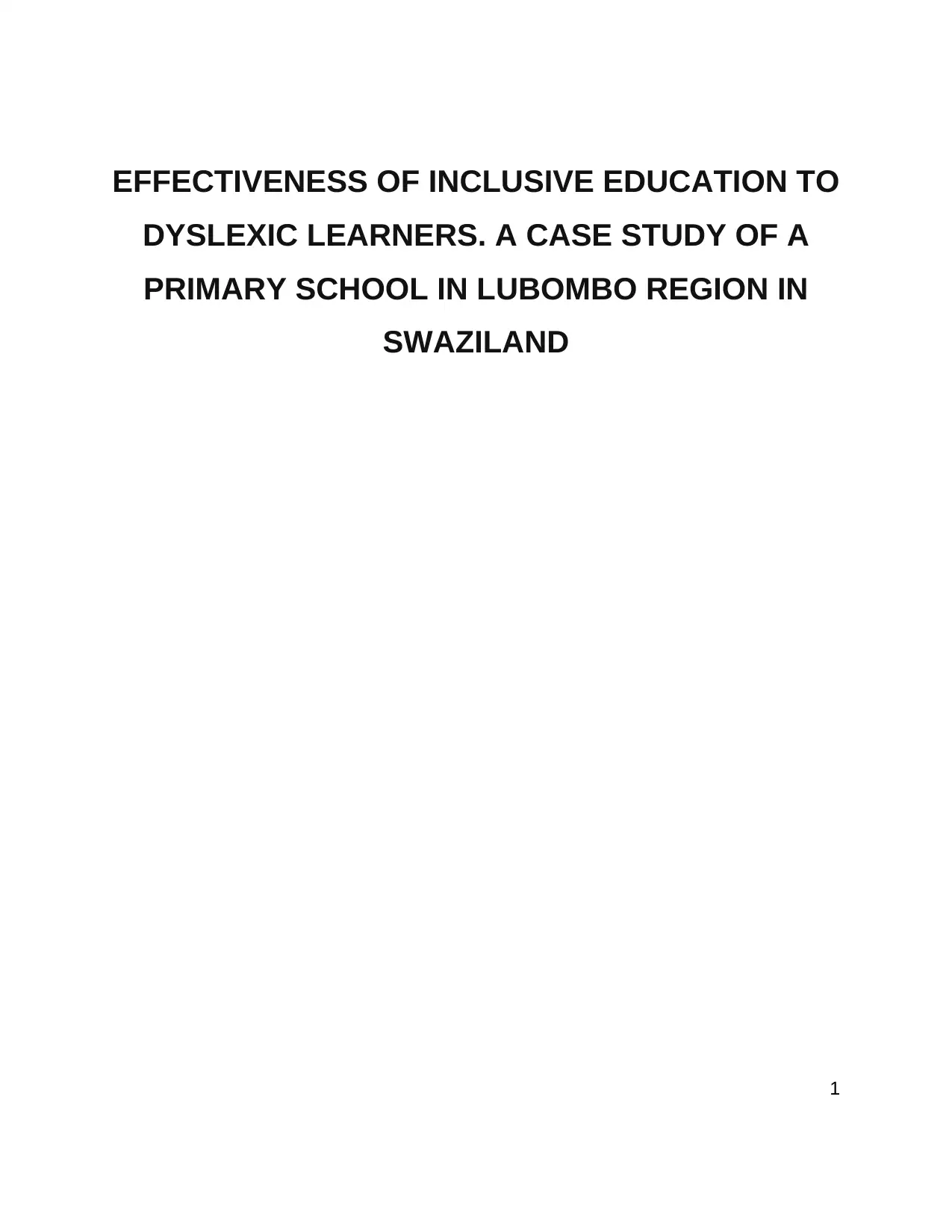
EFFECTIVENESS OF INCLUSIVE EDUCATION TO
DYSLEXIC LEARNERS. A CASE STUDY OF A
PRIMARY SCHOOL IN LUBOMBO REGION IN
SWAZILAND
1
DYSLEXIC LEARNERS. A CASE STUDY OF A
PRIMARY SCHOOL IN LUBOMBO REGION IN
SWAZILAND
1
Secure Best Marks with AI Grader
Need help grading? Try our AI Grader for instant feedback on your assignments.
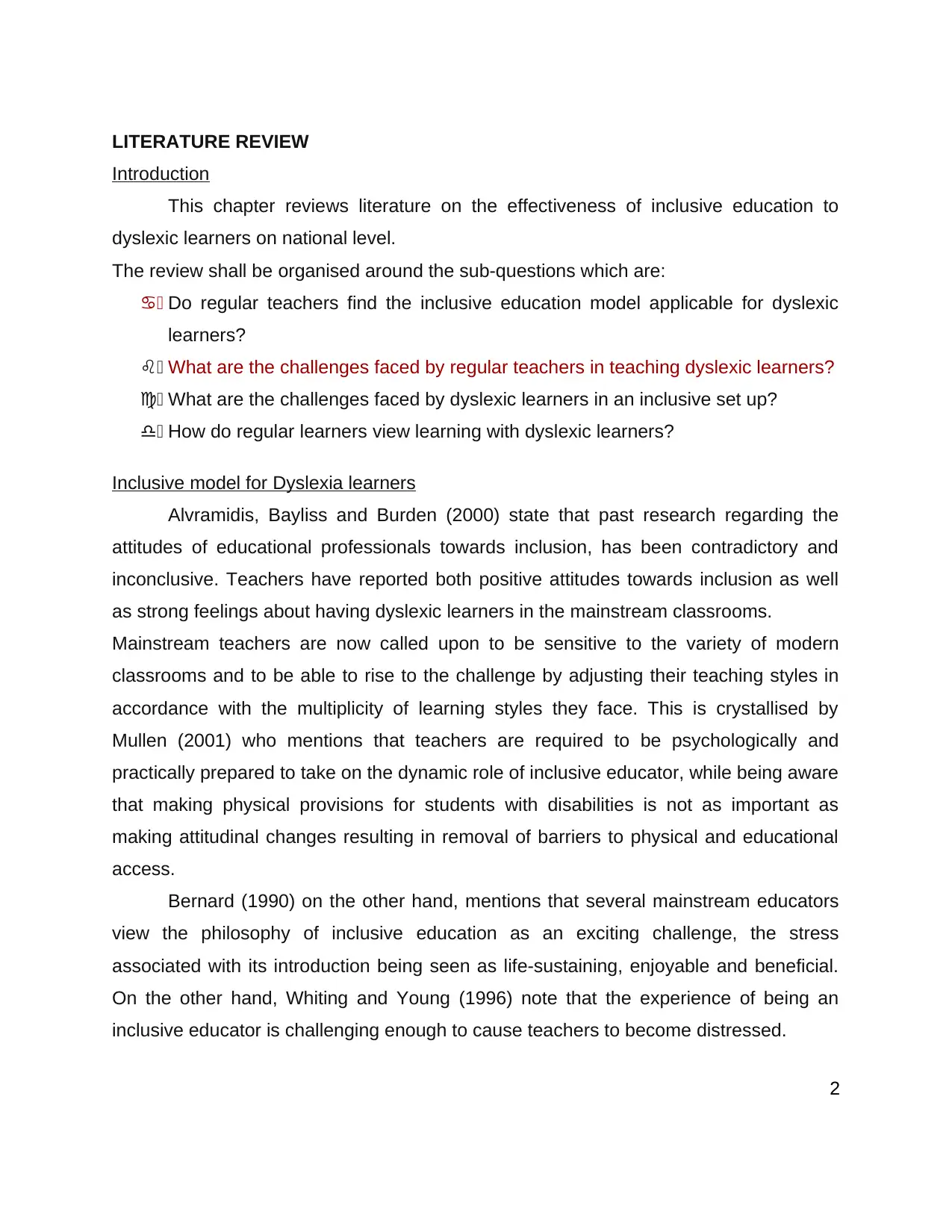
LITERATURE REVIEW
Introduction
This chapter reviews literature on the effectiveness of inclusive education to
dyslexic learners on national level.
The review shall be organised around the sub-questions which are:
)a Do regular teachers find the inclusive education model applicable for dyslexic
learners?
)b What are the challenges faced by regular teachers in teaching dyslexic learners?
)c What are the challenges faced by dyslexic learners in an inclusive set up?
)d How do regular learners view learning with dyslexic learners?
Inclusive model for Dyslexia learners
Alvramidis, Bayliss and Burden (2000) state that past research regarding the
attitudes of educational professionals towards inclusion, has been contradictory and
inconclusive. Teachers have reported both positive attitudes towards inclusion as well
as strong feelings about having dyslexic learners in the mainstream classrooms.
Mainstream teachers are now called upon to be sensitive to the variety of modern
classrooms and to be able to rise to the challenge by adjusting their teaching styles in
accordance with the multiplicity of learning styles they face. This is crystallised by
Mullen (2001) who mentions that teachers are required to be psychologically and
practically prepared to take on the dynamic role of inclusive educator, while being aware
that making physical provisions for students with disabilities is not as important as
making attitudinal changes resulting in removal of barriers to physical and educational
access.
Bernard (1990) on the other hand, mentions that several mainstream educators
view the philosophy of inclusive education as an exciting challenge, the stress
associated with its introduction being seen as life-sustaining, enjoyable and beneficial.
On the other hand, Whiting and Young (1996) note that the experience of being an
inclusive educator is challenging enough to cause teachers to become distressed.
2
Introduction
This chapter reviews literature on the effectiveness of inclusive education to
dyslexic learners on national level.
The review shall be organised around the sub-questions which are:
)a Do regular teachers find the inclusive education model applicable for dyslexic
learners?
)b What are the challenges faced by regular teachers in teaching dyslexic learners?
)c What are the challenges faced by dyslexic learners in an inclusive set up?
)d How do regular learners view learning with dyslexic learners?
Inclusive model for Dyslexia learners
Alvramidis, Bayliss and Burden (2000) state that past research regarding the
attitudes of educational professionals towards inclusion, has been contradictory and
inconclusive. Teachers have reported both positive attitudes towards inclusion as well
as strong feelings about having dyslexic learners in the mainstream classrooms.
Mainstream teachers are now called upon to be sensitive to the variety of modern
classrooms and to be able to rise to the challenge by adjusting their teaching styles in
accordance with the multiplicity of learning styles they face. This is crystallised by
Mullen (2001) who mentions that teachers are required to be psychologically and
practically prepared to take on the dynamic role of inclusive educator, while being aware
that making physical provisions for students with disabilities is not as important as
making attitudinal changes resulting in removal of barriers to physical and educational
access.
Bernard (1990) on the other hand, mentions that several mainstream educators
view the philosophy of inclusive education as an exciting challenge, the stress
associated with its introduction being seen as life-sustaining, enjoyable and beneficial.
On the other hand, Whiting and Young (1996) note that the experience of being an
inclusive educator is challenging enough to cause teachers to become distressed.
2

According to Maciver et al, (2018) inclusion in education refers to a model in
which students with special needs spend their most of the time with general or non-
special students. These inclusive classrooms are designed in such a way that all the
special need students like dyslexic learners can learn or attend classes with regular
students. Students with dyslexia are normal students with a learning disability. These
students are provided with additional help through special instructions if needed.
Currently, many schools are trying to build an educational program in which they try to
build inclusive classrooms for all students as they do not believe in having separate
classrooms. Inclusive classrooms can help dyslexic students to get mixed up with other
mainstream students. Today more than 90% of dyslexic students are placed with other
students in regular classrooms.
According to Westwood, (2018) speaking and learning are one of the most
powerful learning modes for dyslexia students, so these inclusive classrooms provide
great opportunities for dyslexia students to understand and learn with other students. It
is believed that inclusive classrooms motivate dyslexic students and improve their
learning in terms of their learning disability. However, it becomes difficult for teachers to
address regular and dyslexic students together in a common classroom as the grasping
power of regular students is much higher than students with dyslexia. Many teachers
who teaches typical subjects such as maths, do not find inclusive classrooms
appropriate for dyslexic learners, as both the teachers and the students face a range of
considerable difficulties in an inclusive model of learning.
According to the view of Awada and Plana, (2018) regular class teachers
teaching different grade students have many views of teaching positively to their
students using inclusive model for the dyslexic learners. Primary grade regular class
teachers prefer inclusive learning as they can provide the benefit of education for
dyslexia learners. They can work more on making them understand basic language,
learn alphabets and improve their writing skills. This can help dyslexic learners because
if they can understand alphabets, read and write at an early stage of their studies then
there are chances that they will face fewer difficulties in learning in higher grades.
3
which students with special needs spend their most of the time with general or non-
special students. These inclusive classrooms are designed in such a way that all the
special need students like dyslexic learners can learn or attend classes with regular
students. Students with dyslexia are normal students with a learning disability. These
students are provided with additional help through special instructions if needed.
Currently, many schools are trying to build an educational program in which they try to
build inclusive classrooms for all students as they do not believe in having separate
classrooms. Inclusive classrooms can help dyslexic students to get mixed up with other
mainstream students. Today more than 90% of dyslexic students are placed with other
students in regular classrooms.
According to Westwood, (2018) speaking and learning are one of the most
powerful learning modes for dyslexia students, so these inclusive classrooms provide
great opportunities for dyslexia students to understand and learn with other students. It
is believed that inclusive classrooms motivate dyslexic students and improve their
learning in terms of their learning disability. However, it becomes difficult for teachers to
address regular and dyslexic students together in a common classroom as the grasping
power of regular students is much higher than students with dyslexia. Many teachers
who teaches typical subjects such as maths, do not find inclusive classrooms
appropriate for dyslexic learners, as both the teachers and the students face a range of
considerable difficulties in an inclusive model of learning.
According to the view of Awada and Plana, (2018) regular class teachers
teaching different grade students have many views of teaching positively to their
students using inclusive model for the dyslexic learners. Primary grade regular class
teachers prefer inclusive learning as they can provide the benefit of education for
dyslexia learners. They can work more on making them understand basic language,
learn alphabets and improve their writing skills. This can help dyslexic learners because
if they can understand alphabets, read and write at an early stage of their studies then
there are chances that they will face fewer difficulties in learning in higher grades.
3
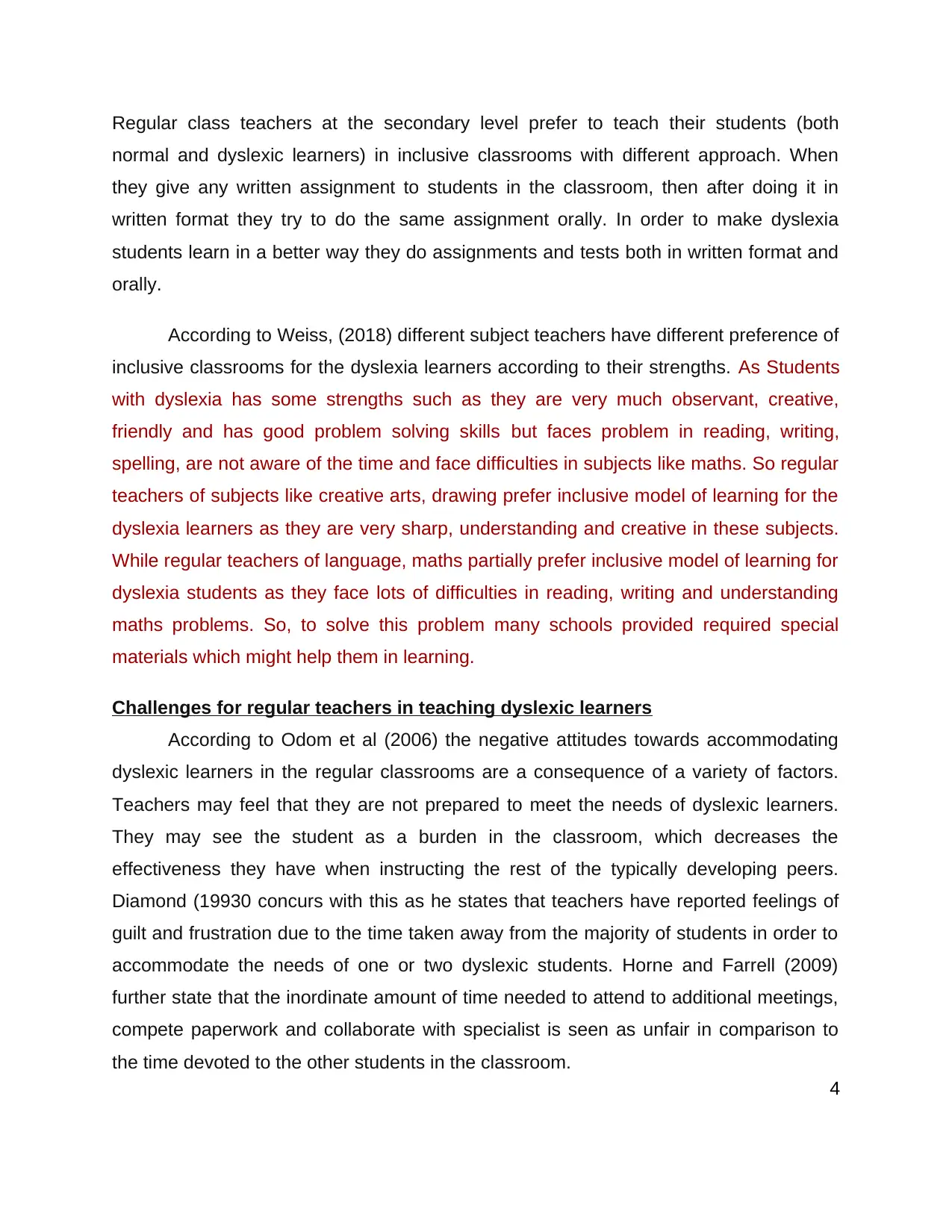
Regular class teachers at the secondary level prefer to teach their students (both
normal and dyslexic learners) in inclusive classrooms with different approach. When
they give any written assignment to students in the classroom, then after doing it in
written format they try to do the same assignment orally. In order to make dyslexia
students learn in a better way they do assignments and tests both in written format and
orally.
According to Weiss, (2018) different subject teachers have different preference of
inclusive classrooms for the dyslexia learners according to their strengths. As Students
with dyslexia has some strengths such as they are very much observant, creative,
friendly and has good problem solving skills but faces problem in reading, writing,
spelling, are not aware of the time and face difficulties in subjects like maths. So regular
teachers of subjects like creative arts, drawing prefer inclusive model of learning for the
dyslexia learners as they are very sharp, understanding and creative in these subjects.
While regular teachers of language, maths partially prefer inclusive model of learning for
dyslexia students as they face lots of difficulties in reading, writing and understanding
maths problems. So, to solve this problem many schools provided required special
materials which might help them in learning.
Challenges for regular teachers in teaching dyslexic learners
According to Odom et al (2006) the negative attitudes towards accommodating
dyslexic learners in the regular classrooms are a consequence of a variety of factors.
Teachers may feel that they are not prepared to meet the needs of dyslexic learners.
They may see the student as a burden in the classroom, which decreases the
effectiveness they have when instructing the rest of the typically developing peers.
Diamond (19930 concurs with this as he states that teachers have reported feelings of
guilt and frustration due to the time taken away from the majority of students in order to
accommodate the needs of one or two dyslexic students. Horne and Farrell (2009)
further state that the inordinate amount of time needed to attend to additional meetings,
compete paperwork and collaborate with specialist is seen as unfair in comparison to
the time devoted to the other students in the classroom.
4
normal and dyslexic learners) in inclusive classrooms with different approach. When
they give any written assignment to students in the classroom, then after doing it in
written format they try to do the same assignment orally. In order to make dyslexia
students learn in a better way they do assignments and tests both in written format and
orally.
According to Weiss, (2018) different subject teachers have different preference of
inclusive classrooms for the dyslexia learners according to their strengths. As Students
with dyslexia has some strengths such as they are very much observant, creative,
friendly and has good problem solving skills but faces problem in reading, writing,
spelling, are not aware of the time and face difficulties in subjects like maths. So regular
teachers of subjects like creative arts, drawing prefer inclusive model of learning for the
dyslexia learners as they are very sharp, understanding and creative in these subjects.
While regular teachers of language, maths partially prefer inclusive model of learning for
dyslexia students as they face lots of difficulties in reading, writing and understanding
maths problems. So, to solve this problem many schools provided required special
materials which might help them in learning.
Challenges for regular teachers in teaching dyslexic learners
According to Odom et al (2006) the negative attitudes towards accommodating
dyslexic learners in the regular classrooms are a consequence of a variety of factors.
Teachers may feel that they are not prepared to meet the needs of dyslexic learners.
They may see the student as a burden in the classroom, which decreases the
effectiveness they have when instructing the rest of the typically developing peers.
Diamond (19930 concurs with this as he states that teachers have reported feelings of
guilt and frustration due to the time taken away from the majority of students in order to
accommodate the needs of one or two dyslexic students. Horne and Farrell (2009)
further state that the inordinate amount of time needed to attend to additional meetings,
compete paperwork and collaborate with specialist is seen as unfair in comparison to
the time devoted to the other students in the classroom.
4
Secure Best Marks with AI Grader
Need help grading? Try our AI Grader for instant feedback on your assignments.
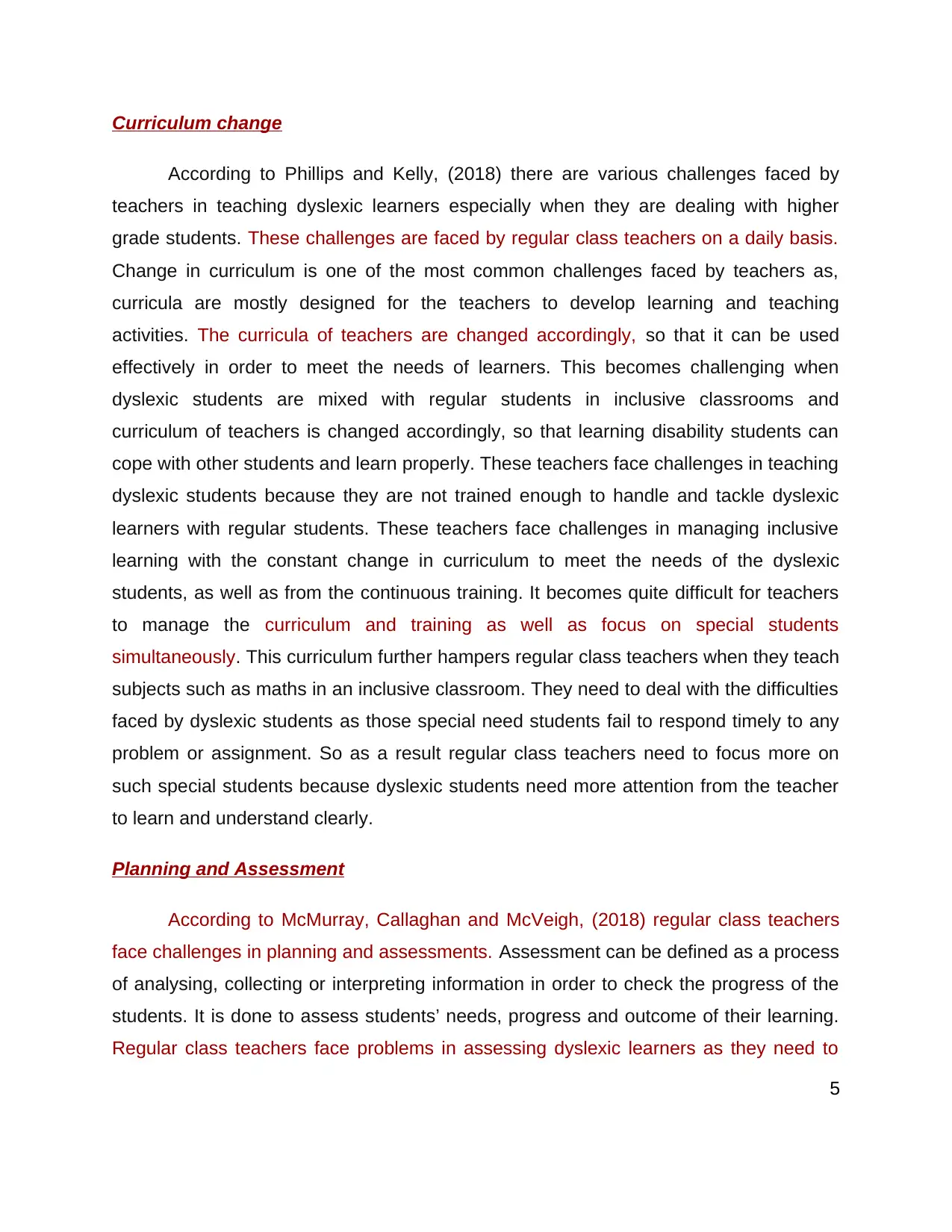
Curriculum change
According to Phillips and Kelly, (2018) there are various challenges faced by
teachers in teaching dyslexic learners especially when they are dealing with higher
grade students. These challenges are faced by regular class teachers on a daily basis.
Change in curriculum is one of the most common challenges faced by teachers as,
curricula are mostly designed for the teachers to develop learning and teaching
activities. The curricula of teachers are changed accordingly, so that it can be used
effectively in order to meet the needs of learners. This becomes challenging when
dyslexic students are mixed with regular students in inclusive classrooms and
curriculum of teachers is changed accordingly, so that learning disability students can
cope with other students and learn properly. These teachers face challenges in teaching
dyslexic students because they are not trained enough to handle and tackle dyslexic
learners with regular students. These teachers face challenges in managing inclusive
learning with the constant change in curriculum to meet the needs of the dyslexic
students, as well as from the continuous training. It becomes quite difficult for teachers
to manage the curriculum and training as well as focus on special students
simultaneously. This curriculum further hampers regular class teachers when they teach
subjects such as maths in an inclusive classroom. They need to deal with the difficulties
faced by dyslexic students as those special need students fail to respond timely to any
problem or assignment. So as a result regular class teachers need to focus more on
such special students because dyslexic students need more attention from the teacher
to learn and understand clearly.
Planning and Assessment
According to McMurray, Callaghan and McVeigh, (2018) regular class teachers
face challenges in planning and assessments. Assessment can be defined as a process
of analysing, collecting or interpreting information in order to check the progress of the
students. It is done to assess students’ needs, progress and outcome of their learning.
Regular class teachers face problems in assessing dyslexic learners as they need to
5
According to Phillips and Kelly, (2018) there are various challenges faced by
teachers in teaching dyslexic learners especially when they are dealing with higher
grade students. These challenges are faced by regular class teachers on a daily basis.
Change in curriculum is one of the most common challenges faced by teachers as,
curricula are mostly designed for the teachers to develop learning and teaching
activities. The curricula of teachers are changed accordingly, so that it can be used
effectively in order to meet the needs of learners. This becomes challenging when
dyslexic students are mixed with regular students in inclusive classrooms and
curriculum of teachers is changed accordingly, so that learning disability students can
cope with other students and learn properly. These teachers face challenges in teaching
dyslexic students because they are not trained enough to handle and tackle dyslexic
learners with regular students. These teachers face challenges in managing inclusive
learning with the constant change in curriculum to meet the needs of the dyslexic
students, as well as from the continuous training. It becomes quite difficult for teachers
to manage the curriculum and training as well as focus on special students
simultaneously. This curriculum further hampers regular class teachers when they teach
subjects such as maths in an inclusive classroom. They need to deal with the difficulties
faced by dyslexic students as those special need students fail to respond timely to any
problem or assignment. So as a result regular class teachers need to focus more on
such special students because dyslexic students need more attention from the teacher
to learn and understand clearly.
Planning and Assessment
According to McMurray, Callaghan and McVeigh, (2018) regular class teachers
face challenges in planning and assessments. Assessment can be defined as a process
of analysing, collecting or interpreting information in order to check the progress of the
students. It is done to assess students’ needs, progress and outcome of their learning.
Regular class teachers face problems in assessing dyslexic learners as they need to
5
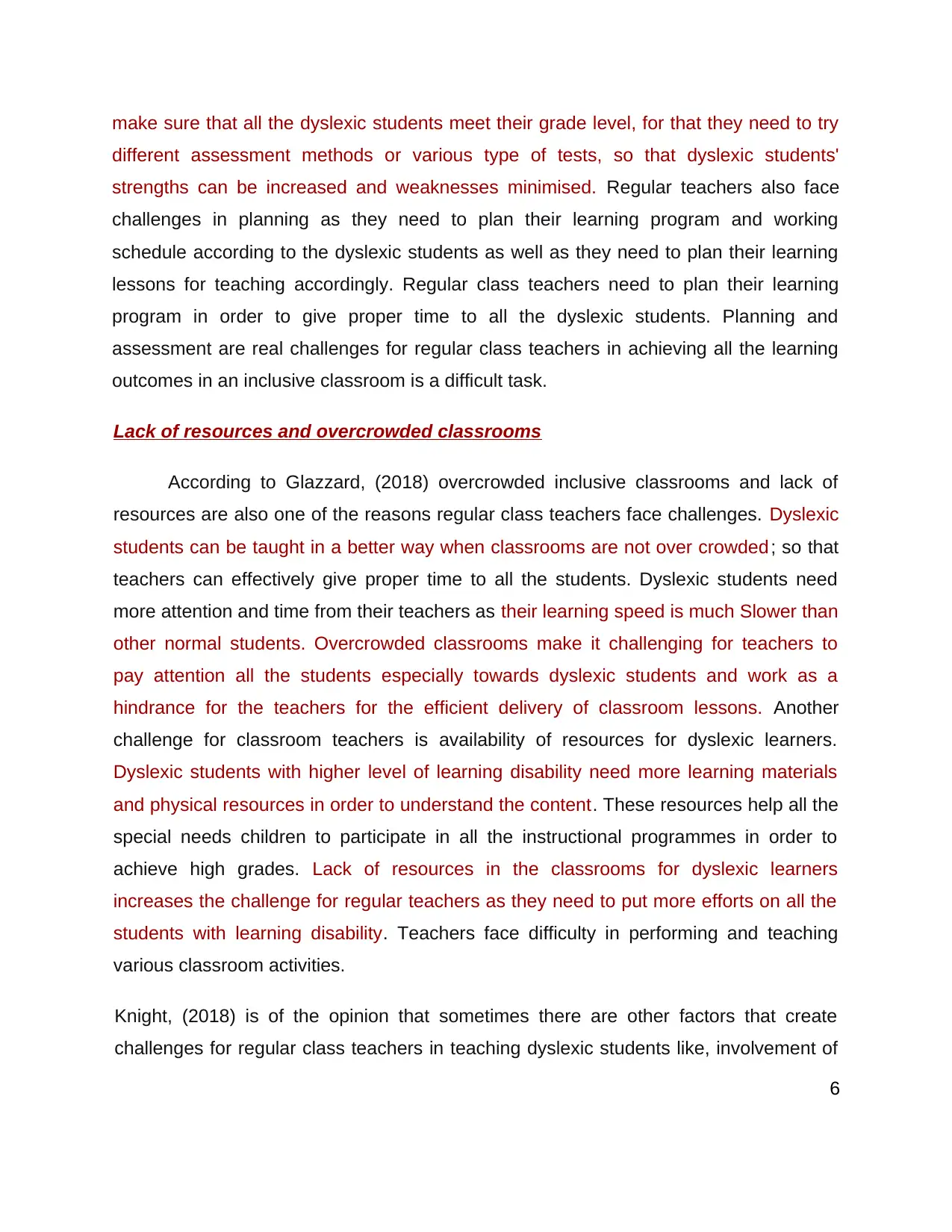
make sure that all the dyslexic students meet their grade level, for that they need to try
different assessment methods or various type of tests, so that dyslexic students'
strengths can be increased and weaknesses minimised. Regular teachers also face
challenges in planning as they need to plan their learning program and working
schedule according to the dyslexic students as well as they need to plan their learning
lessons for teaching accordingly. Regular class teachers need to plan their learning
program in order to give proper time to all the dyslexic students. Planning and
assessment are real challenges for regular class teachers in achieving all the learning
outcomes in an inclusive classroom is a difficult task.
Lack of resources and overcrowded classrooms
According to Glazzard, (2018) overcrowded inclusive classrooms and lack of
resources are also one of the reasons regular class teachers face challenges. Dyslexic
students can be taught in a better way when classrooms are not over crowded ; so that
teachers can effectively give proper time to all the students. Dyslexic students need
more attention and time from their teachers as their learning speed is much Slower than
other normal students. Overcrowded classrooms make it challenging for teachers to
pay attention all the students especially towards dyslexic students and work as a
hindrance for the teachers for the efficient delivery of classroom lessons. Another
challenge for classroom teachers is availability of resources for dyslexic learners.
Dyslexic students with higher level of learning disability need more learning materials
and physical resources in order to understand the content. These resources help all the
special needs children to participate in all the instructional programmes in order to
achieve high grades. Lack of resources in the classrooms for dyslexic learners
increases the challenge for regular teachers as they need to put more efforts on all the
students with learning disability. Teachers face difficulty in performing and teaching
various classroom activities.
Knight, (2018) is of the opinion that sometimes there are other factors that create
challenges for regular class teachers in teaching dyslexic students like, involvement of
6
different assessment methods or various type of tests, so that dyslexic students'
strengths can be increased and weaknesses minimised. Regular teachers also face
challenges in planning as they need to plan their learning program and working
schedule according to the dyslexic students as well as they need to plan their learning
lessons for teaching accordingly. Regular class teachers need to plan their learning
program in order to give proper time to all the dyslexic students. Planning and
assessment are real challenges for regular class teachers in achieving all the learning
outcomes in an inclusive classroom is a difficult task.
Lack of resources and overcrowded classrooms
According to Glazzard, (2018) overcrowded inclusive classrooms and lack of
resources are also one of the reasons regular class teachers face challenges. Dyslexic
students can be taught in a better way when classrooms are not over crowded ; so that
teachers can effectively give proper time to all the students. Dyslexic students need
more attention and time from their teachers as their learning speed is much Slower than
other normal students. Overcrowded classrooms make it challenging for teachers to
pay attention all the students especially towards dyslexic students and work as a
hindrance for the teachers for the efficient delivery of classroom lessons. Another
challenge for classroom teachers is availability of resources for dyslexic learners.
Dyslexic students with higher level of learning disability need more learning materials
and physical resources in order to understand the content. These resources help all the
special needs children to participate in all the instructional programmes in order to
achieve high grades. Lack of resources in the classrooms for dyslexic learners
increases the challenge for regular teachers as they need to put more efforts on all the
students with learning disability. Teachers face difficulty in performing and teaching
various classroom activities.
Knight, (2018) is of the opinion that sometimes there are other factors that create
challenges for regular class teachers in teaching dyslexic students like, involvement of
6
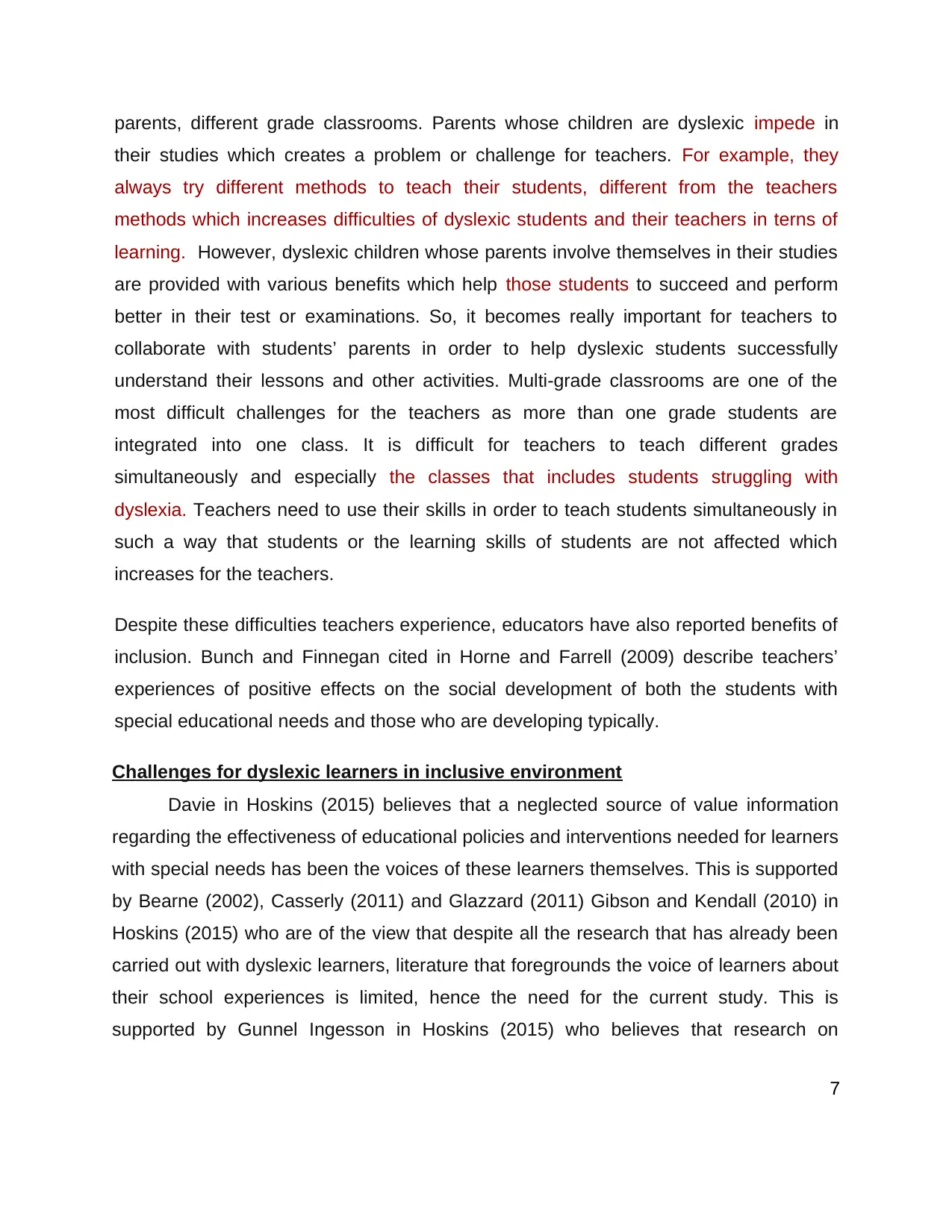
parents, different grade classrooms. Parents whose children are dyslexic impede in
their studies which creates a problem or challenge for teachers. For example, they
always try different methods to teach their students, different from the teachers
methods which increases difficulties of dyslexic students and their teachers in terns of
learning. However, dyslexic children whose parents involve themselves in their studies
are provided with various benefits which help those students to succeed and perform
better in their test or examinations. So, it becomes really important for teachers to
collaborate with students’ parents in order to help dyslexic students successfully
understand their lessons and other activities. Multi-grade classrooms are one of the
most difficult challenges for the teachers as more than one grade students are
integrated into one class. It is difficult for teachers to teach different grades
simultaneously and especially the classes that includes students struggling with
dyslexia. Teachers need to use their skills in order to teach students simultaneously in
such a way that students or the learning skills of students are not affected which
increases for the teachers.
Despite these difficulties teachers experience, educators have also reported benefits of
inclusion. Bunch and Finnegan cited in Horne and Farrell (2009) describe teachers’
experiences of positive effects on the social development of both the students with
special educational needs and those who are developing typically.
Challenges for dyslexic learners in inclusive environment
Davie in Hoskins (2015) believes that a neglected source of value information
regarding the effectiveness of educational policies and interventions needed for learners
with special needs has been the voices of these learners themselves. This is supported
by Bearne (2002), Casserly (2011) and Glazzard (2011) Gibson and Kendall (2010) in
Hoskins (2015) who are of the view that despite all the research that has already been
carried out with dyslexic learners, literature that foregrounds the voice of learners about
their school experiences is limited, hence the need for the current study. This is
supported by Gunnel Ingesson in Hoskins (2015) who believes that research on
7
their studies which creates a problem or challenge for teachers. For example, they
always try different methods to teach their students, different from the teachers
methods which increases difficulties of dyslexic students and their teachers in terns of
learning. However, dyslexic children whose parents involve themselves in their studies
are provided with various benefits which help those students to succeed and perform
better in their test or examinations. So, it becomes really important for teachers to
collaborate with students’ parents in order to help dyslexic students successfully
understand their lessons and other activities. Multi-grade classrooms are one of the
most difficult challenges for the teachers as more than one grade students are
integrated into one class. It is difficult for teachers to teach different grades
simultaneously and especially the classes that includes students struggling with
dyslexia. Teachers need to use their skills in order to teach students simultaneously in
such a way that students or the learning skills of students are not affected which
increases for the teachers.
Despite these difficulties teachers experience, educators have also reported benefits of
inclusion. Bunch and Finnegan cited in Horne and Farrell (2009) describe teachers’
experiences of positive effects on the social development of both the students with
special educational needs and those who are developing typically.
Challenges for dyslexic learners in inclusive environment
Davie in Hoskins (2015) believes that a neglected source of value information
regarding the effectiveness of educational policies and interventions needed for learners
with special needs has been the voices of these learners themselves. This is supported
by Bearne (2002), Casserly (2011) and Glazzard (2011) Gibson and Kendall (2010) in
Hoskins (2015) who are of the view that despite all the research that has already been
carried out with dyslexic learners, literature that foregrounds the voice of learners about
their school experiences is limited, hence the need for the current study. This is
supported by Gunnel Ingesson in Hoskins (2015) who believes that research on
7
Paraphrase This Document
Need a fresh take? Get an instant paraphrase of this document with our AI Paraphraser

learners with dyslexia is frequently based on parent-teacher ratings and rarely based on
accounts of the affected students themselves.
Dyslexic learners are likely to encounter a large number of problems when
learning foreign languages. (Downey, Snyder and Hill 2000) Moreover, students with
dyslexia often suffer from their environment’s reaction to their special situation.
Ignorance about learning disabilities also aggravates the situation of dyslexic students.
Most people have vague ideas about the causes of dyslexia, and they often consider it
as a sign of low intelligence (Ranaldi 2003), which results in the stigmatization of
dyslexics.
Self-esteem in dyslexic learners
Everett and Oswald, (2018) state that students with dyslexia face many
difficulties in an inclusive environment in schools. They need to cope with other regular
students along with their own learning difficulties. They face difficulty in reading writing,
spellings, building social skills and relationships. They are low in self-esteem and
confidence, lack organizational and time management skills and many other
challenges. These students face difficulty in understanding and following continuous
oral instructions. For example, if they are told to open page number 44 of chapter 5 of
their Literature text they will get confused. Teachers need to explain everything slowly
as they cannot take multiple instructions simultaneously. They also face difficulty in
listening and taking notes at the same time in inclusive classrooms. Sometimes they
even have issues in pronouncing, remembering and understanding new words and
abbreviations. All these factors work as a challenge for dyslexic students in an inclusive
environment. Writing is also one of the major challenges faced by dyslexic students as
they take longer time to write and, they often write in a very untidy or incoherent way.
Teachers and other students' behaviour and patience is one of the major factor that
work as a challenge for dyslexic learners: the attitude of teachers and the other
students often present challenges for the Dyslexic learners that is if they are not treated
well then their confidence is affected and they can become more self-conscious
8
accounts of the affected students themselves.
Dyslexic learners are likely to encounter a large number of problems when
learning foreign languages. (Downey, Snyder and Hill 2000) Moreover, students with
dyslexia often suffer from their environment’s reaction to their special situation.
Ignorance about learning disabilities also aggravates the situation of dyslexic students.
Most people have vague ideas about the causes of dyslexia, and they often consider it
as a sign of low intelligence (Ranaldi 2003), which results in the stigmatization of
dyslexics.
Self-esteem in dyslexic learners
Everett and Oswald, (2018) state that students with dyslexia face many
difficulties in an inclusive environment in schools. They need to cope with other regular
students along with their own learning difficulties. They face difficulty in reading writing,
spellings, building social skills and relationships. They are low in self-esteem and
confidence, lack organizational and time management skills and many other
challenges. These students face difficulty in understanding and following continuous
oral instructions. For example, if they are told to open page number 44 of chapter 5 of
their Literature text they will get confused. Teachers need to explain everything slowly
as they cannot take multiple instructions simultaneously. They also face difficulty in
listening and taking notes at the same time in inclusive classrooms. Sometimes they
even have issues in pronouncing, remembering and understanding new words and
abbreviations. All these factors work as a challenge for dyslexic students in an inclusive
environment. Writing is also one of the major challenges faced by dyslexic students as
they take longer time to write and, they often write in a very untidy or incoherent way.
Teachers and other students' behaviour and patience is one of the major factor that
work as a challenge for dyslexic learners: the attitude of teachers and the other
students often present challenges for the Dyslexic learners that is if they are not treated
well then their confidence is affected and they can become more self-conscious
8
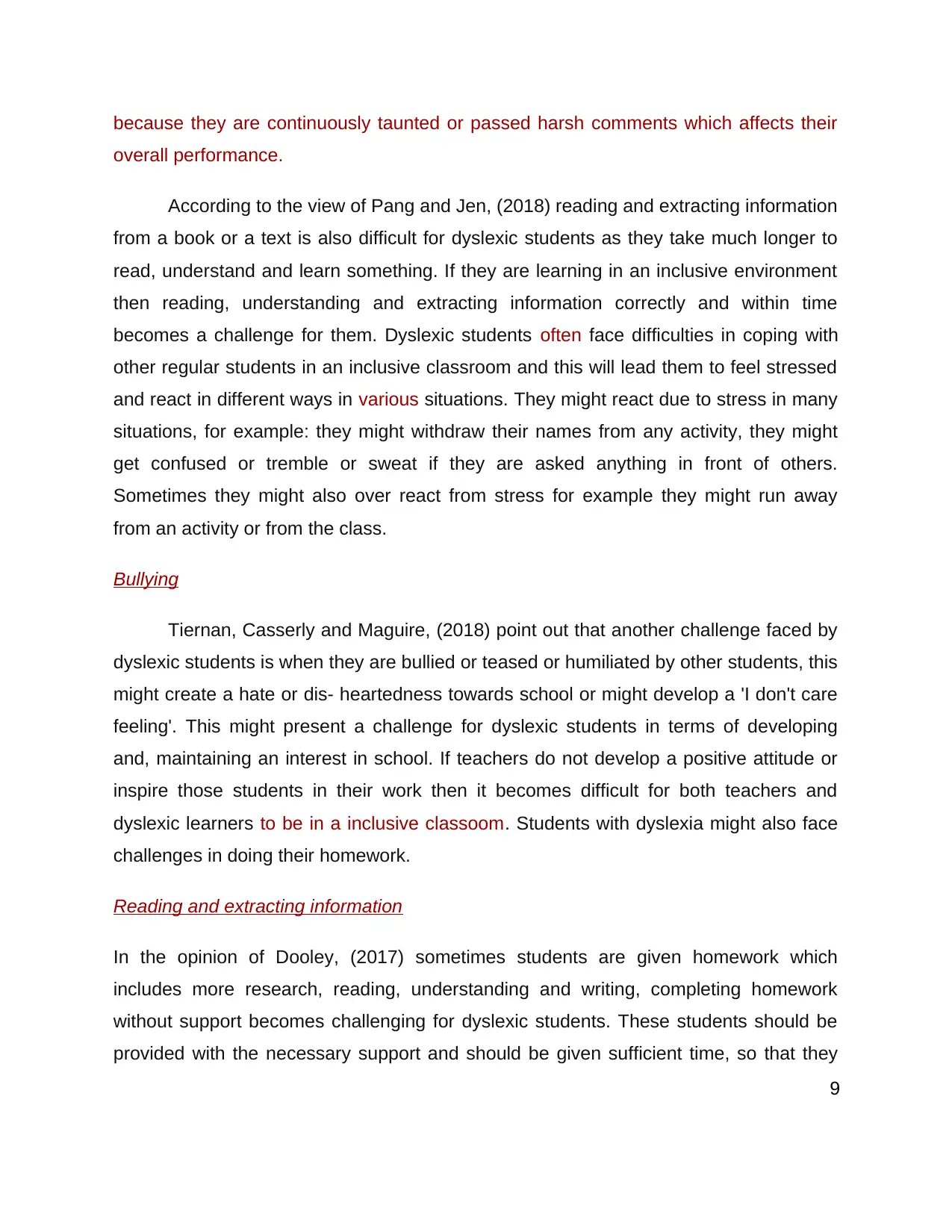
because they are continuously taunted or passed harsh comments which affects their
overall performance.
According to the view of Pang and Jen, (2018) reading and extracting information
from a book or a text is also difficult for dyslexic students as they take much longer to
read, understand and learn something. If they are learning in an inclusive environment
then reading, understanding and extracting information correctly and within time
becomes a challenge for them. Dyslexic students often face difficulties in coping with
other regular students in an inclusive classroom and this will lead them to feel stressed
and react in different ways in various situations. They might react due to stress in many
situations, for example: they might withdraw their names from any activity, they might
get confused or tremble or sweat if they are asked anything in front of others.
Sometimes they might also over react from stress for example they might run away
from an activity or from the class.
Bullying
Tiernan, Casserly and Maguire, (2018) point out that another challenge faced by
dyslexic students is when they are bullied or teased or humiliated by other students, this
might create a hate or dis- heartedness towards school or might develop a 'I don't care
feeling'. This might present a challenge for dyslexic students in terms of developing
and, maintaining an interest in school. If teachers do not develop a positive attitude or
inspire those students in their work then it becomes difficult for both teachers and
dyslexic learners to be in a inclusive classoom. Students with dyslexia might also face
challenges in doing their homework.
Reading and extracting information
In the opinion of Dooley, (2017) sometimes students are given homework which
includes more research, reading, understanding and writing, completing homework
without support becomes challenging for dyslexic students. These students should be
provided with the necessary support and should be given sufficient time, so that they
9
overall performance.
According to the view of Pang and Jen, (2018) reading and extracting information
from a book or a text is also difficult for dyslexic students as they take much longer to
read, understand and learn something. If they are learning in an inclusive environment
then reading, understanding and extracting information correctly and within time
becomes a challenge for them. Dyslexic students often face difficulties in coping with
other regular students in an inclusive classroom and this will lead them to feel stressed
and react in different ways in various situations. They might react due to stress in many
situations, for example: they might withdraw their names from any activity, they might
get confused or tremble or sweat if they are asked anything in front of others.
Sometimes they might also over react from stress for example they might run away
from an activity or from the class.
Bullying
Tiernan, Casserly and Maguire, (2018) point out that another challenge faced by
dyslexic students is when they are bullied or teased or humiliated by other students, this
might create a hate or dis- heartedness towards school or might develop a 'I don't care
feeling'. This might present a challenge for dyslexic students in terms of developing
and, maintaining an interest in school. If teachers do not develop a positive attitude or
inspire those students in their work then it becomes difficult for both teachers and
dyslexic learners to be in a inclusive classoom. Students with dyslexia might also face
challenges in doing their homework.
Reading and extracting information
In the opinion of Dooley, (2017) sometimes students are given homework which
includes more research, reading, understanding and writing, completing homework
without support becomes challenging for dyslexic students. These students should be
provided with the necessary support and should be given sufficient time, so that they
9
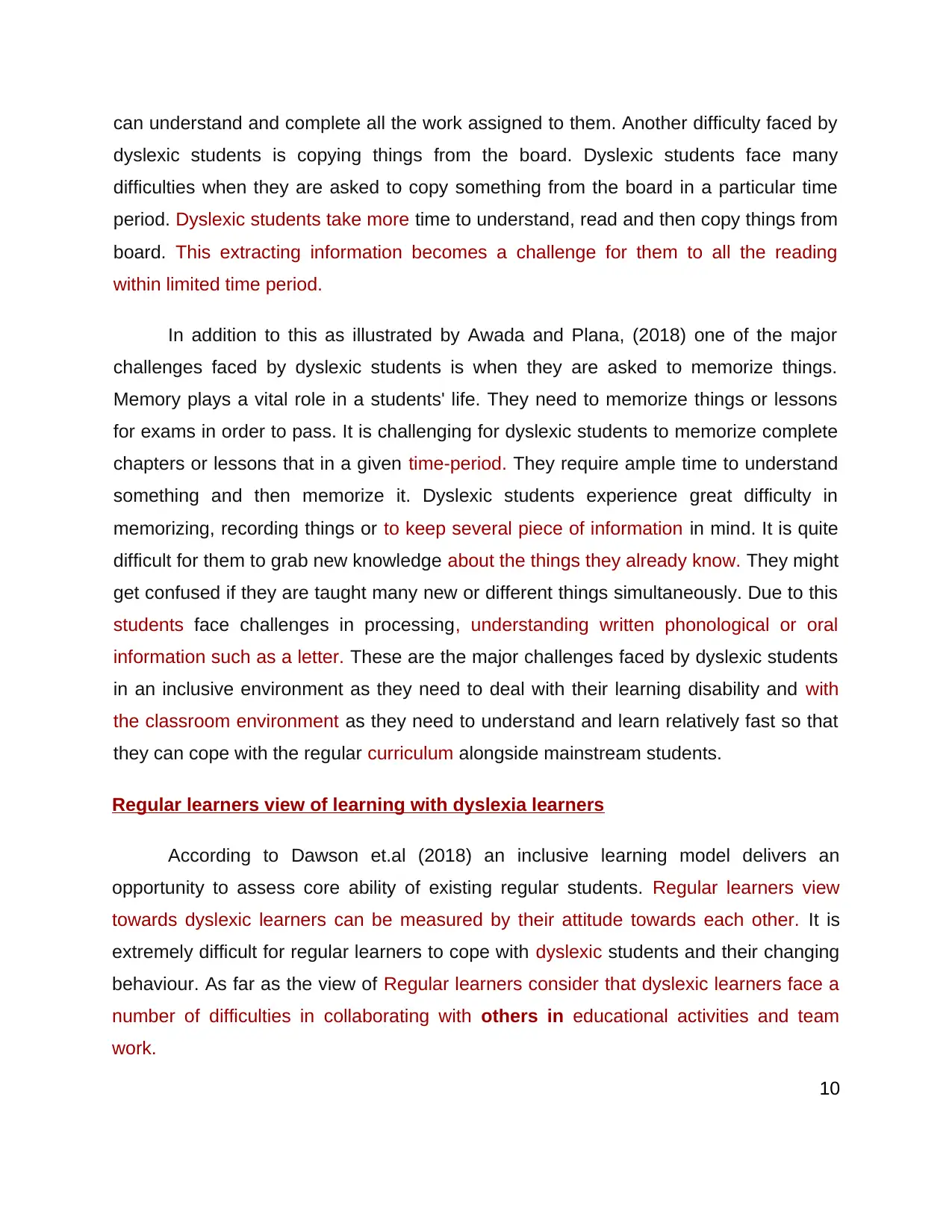
can understand and complete all the work assigned to them. Another difficulty faced by
dyslexic students is copying things from the board. Dyslexic students face many
difficulties when they are asked to copy something from the board in a particular time
period. Dyslexic students take more time to understand, read and then copy things from
board. This extracting information becomes a challenge for them to all the reading
within limited time period.
In addition to this as illustrated by Awada and Plana, (2018) one of the major
challenges faced by dyslexic students is when they are asked to memorize things.
Memory plays a vital role in a students' life. They need to memorize things or lessons
for exams in order to pass. It is challenging for dyslexic students to memorize complete
chapters or lessons that in a given time-period. They require ample time to understand
something and then memorize it. Dyslexic students experience great difficulty in
memorizing, recording things or to keep several piece of information in mind. It is quite
difficult for them to grab new knowledge about the things they already know. They might
get confused if they are taught many new or different things simultaneously. Due to this
students face challenges in processing, understanding written phonological or oral
information such as a letter. These are the major challenges faced by dyslexic students
in an inclusive environment as they need to deal with their learning disability and with
the classroom environment as they need to understand and learn relatively fast so that
they can cope with the regular curriculum alongside mainstream students.
Regular learners view of learning with dyslexia learners
According to Dawson et.al (2018) an inclusive learning model delivers an
opportunity to assess core ability of existing regular students. Regular learners view
towards dyslexic learners can be measured by their attitude towards each other. It is
extremely difficult for regular learners to cope with dyslexic students and their changing
behaviour. As far as the view of Regular learners consider that dyslexic learners face a
number of difficulties in collaborating with others in educational activities and team
work.
10
dyslexic students is copying things from the board. Dyslexic students face many
difficulties when they are asked to copy something from the board in a particular time
period. Dyslexic students take more time to understand, read and then copy things from
board. This extracting information becomes a challenge for them to all the reading
within limited time period.
In addition to this as illustrated by Awada and Plana, (2018) one of the major
challenges faced by dyslexic students is when they are asked to memorize things.
Memory plays a vital role in a students' life. They need to memorize things or lessons
for exams in order to pass. It is challenging for dyslexic students to memorize complete
chapters or lessons that in a given time-period. They require ample time to understand
something and then memorize it. Dyslexic students experience great difficulty in
memorizing, recording things or to keep several piece of information in mind. It is quite
difficult for them to grab new knowledge about the things they already know. They might
get confused if they are taught many new or different things simultaneously. Due to this
students face challenges in processing, understanding written phonological or oral
information such as a letter. These are the major challenges faced by dyslexic students
in an inclusive environment as they need to deal with their learning disability and with
the classroom environment as they need to understand and learn relatively fast so that
they can cope with the regular curriculum alongside mainstream students.
Regular learners view of learning with dyslexia learners
According to Dawson et.al (2018) an inclusive learning model delivers an
opportunity to assess core ability of existing regular students. Regular learners view
towards dyslexic learners can be measured by their attitude towards each other. It is
extremely difficult for regular learners to cope with dyslexic students and their changing
behaviour. As far as the view of Regular learners consider that dyslexic learners face a
number of difficulties in collaborating with others in educational activities and team
work.
10
Secure Best Marks with AI Grader
Need help grading? Try our AI Grader for instant feedback on your assignments.
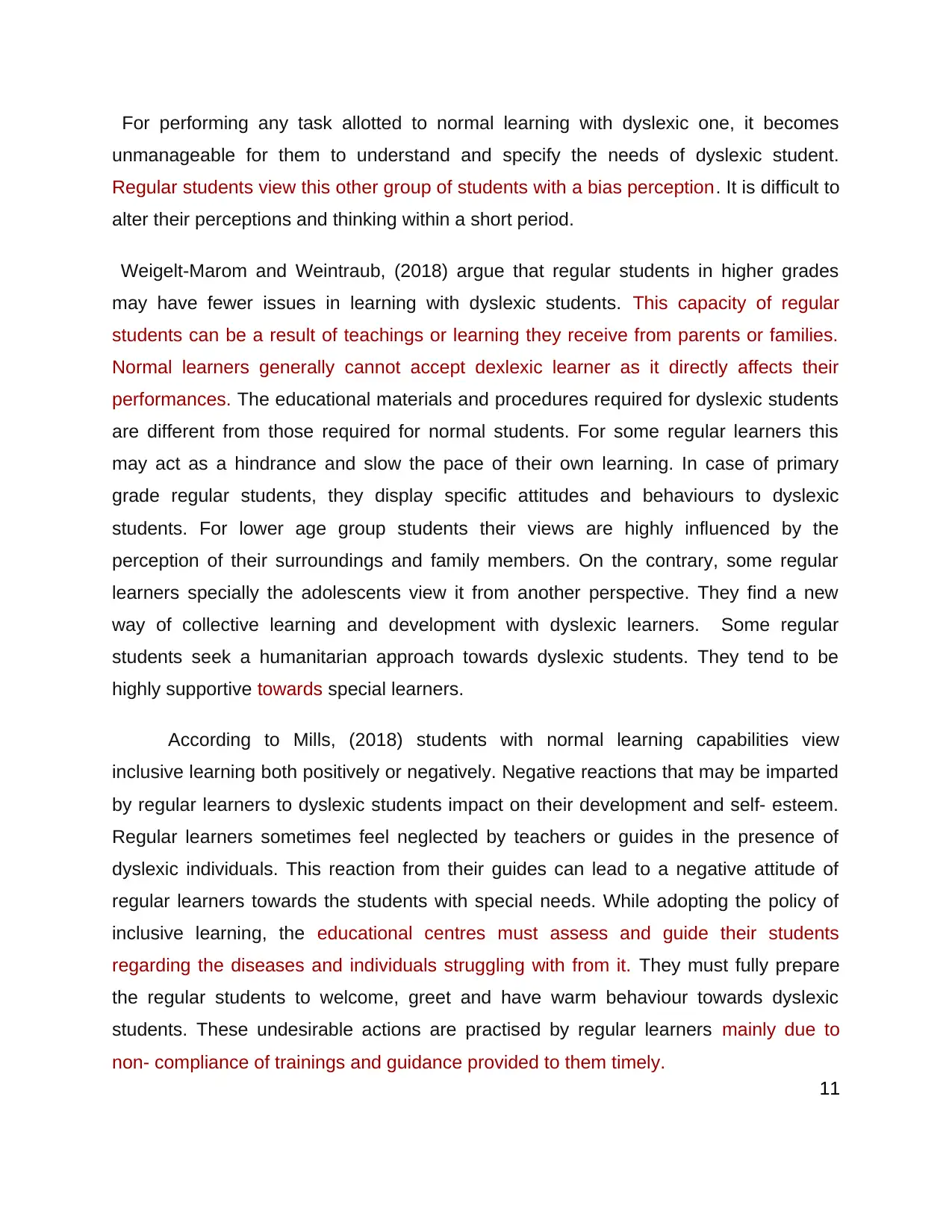
For performing any task allotted to normal learning with dyslexic one, it becomes
unmanageable for them to understand and specify the needs of dyslexic student.
Regular students view this other group of students with a bias perception. It is difficult to
alter their perceptions and thinking within a short period.
Weigelt-Marom and Weintraub, (2018) argue that regular students in higher grades
may have fewer issues in learning with dyslexic students. This capacity of regular
students can be a result of teachings or learning they receive from parents or families.
Normal learners generally cannot accept dexlexic learner as it directly affects their
performances. The educational materials and procedures required for dyslexic students
are different from those required for normal students. For some regular learners this
may act as a hindrance and slow the pace of their own learning. In case of primary
grade regular students, they display specific attitudes and behaviours to dyslexic
students. For lower age group students their views are highly influenced by the
perception of their surroundings and family members. On the contrary, some regular
learners specially the adolescents view it from another perspective. They find a new
way of collective learning and development with dyslexic learners. Some regular
students seek a humanitarian approach towards dyslexic students. They tend to be
highly supportive towards special learners.
According to Mills, (2018) students with normal learning capabilities view
inclusive learning both positively or negatively. Negative reactions that may be imparted
by regular learners to dyslexic students impact on their development and self- esteem.
Regular learners sometimes feel neglected by teachers or guides in the presence of
dyslexic individuals. This reaction from their guides can lead to a negative attitude of
regular learners towards the students with special needs. While adopting the policy of
inclusive learning, the educational centres must assess and guide their students
regarding the diseases and individuals struggling with from it. They must fully prepare
the regular students to welcome, greet and have warm behaviour towards dyslexic
students. These undesirable actions are practised by regular learners mainly due to
non- compliance of trainings and guidance provided to them timely.
11
unmanageable for them to understand and specify the needs of dyslexic student.
Regular students view this other group of students with a bias perception. It is difficult to
alter their perceptions and thinking within a short period.
Weigelt-Marom and Weintraub, (2018) argue that regular students in higher grades
may have fewer issues in learning with dyslexic students. This capacity of regular
students can be a result of teachings or learning they receive from parents or families.
Normal learners generally cannot accept dexlexic learner as it directly affects their
performances. The educational materials and procedures required for dyslexic students
are different from those required for normal students. For some regular learners this
may act as a hindrance and slow the pace of their own learning. In case of primary
grade regular students, they display specific attitudes and behaviours to dyslexic
students. For lower age group students their views are highly influenced by the
perception of their surroundings and family members. On the contrary, some regular
learners specially the adolescents view it from another perspective. They find a new
way of collective learning and development with dyslexic learners. Some regular
students seek a humanitarian approach towards dyslexic students. They tend to be
highly supportive towards special learners.
According to Mills, (2018) students with normal learning capabilities view
inclusive learning both positively or negatively. Negative reactions that may be imparted
by regular learners to dyslexic students impact on their development and self- esteem.
Regular learners sometimes feel neglected by teachers or guides in the presence of
dyslexic individuals. This reaction from their guides can lead to a negative attitude of
regular learners towards the students with special needs. While adopting the policy of
inclusive learning, the educational centres must assess and guide their students
regarding the diseases and individuals struggling with from it. They must fully prepare
the regular students to welcome, greet and have warm behaviour towards dyslexic
students. These undesirable actions are practised by regular learners mainly due to
non- compliance of trainings and guidance provided to them timely.
11

Molster and Nes, (2018) concur with this when they mention that the positive responses
of regular learners towards the students with specific needs help regular learners to
develop sensible human behaviour. The regular students sometimes support dyslexic
individuals to understand complex concepts. As far as the views of secondary or higher
grade students are considered, they are more responsive and sensitized to many of the
problems faced by dyslexic type students or learners. The perceptions of normal or
regular learners to dyslexia has now been raised by education and awareness. Many
articles and journals have suggested imparting advanced support to dyslexic students.
As per the opinion of Mills, (2018) the problems that regular learners face is due in part
to the inclusion of certain factors that influence their studying or learning patterns.
Regular or normal students may sometimes get irritated by the changes that are made
to meet the needs of special students. The arrangements in the working schedule or
time distribution for regular students can be constrained. Also, the perspectives of
regular learners towards special students is negatively influenced by assessments and
scoring criteria that are being altered according to dyslexic type learners. Moreover, the
repetitions made in class to accommodate dyslexic learners tend to lead to monotonous
learning and therefore a sense of boredom among regular students. In such a scenario,
parenting and teaching offer a helping hand in improvizing the sensibility of regular
learners towards students with special needs. Teachers and parents need to be
responsible for creating and promoting a friendly approach towards dyslexic learners
within their students. This will be helpful to deliver a friendly, acceptable and stress-free
environment of learning to both types of learners. Regular learners can be informed and
guided regarding the severe problems faced by dyslexic learners. This could cultivate a
sense of empathy among them and they may provide greater support and motivation to
special learners studying in their classrooms.
CONCLUSION
This chapter reviewed literature related to the study of the effectiveness of
inclusive education to dyslexic learners. Significantly, it looked at the regular class
teachers’ and regular learners’ perspectives and challenges in having dyslexic learners
12
of regular learners towards the students with specific needs help regular learners to
develop sensible human behaviour. The regular students sometimes support dyslexic
individuals to understand complex concepts. As far as the views of secondary or higher
grade students are considered, they are more responsive and sensitized to many of the
problems faced by dyslexic type students or learners. The perceptions of normal or
regular learners to dyslexia has now been raised by education and awareness. Many
articles and journals have suggested imparting advanced support to dyslexic students.
As per the opinion of Mills, (2018) the problems that regular learners face is due in part
to the inclusion of certain factors that influence their studying or learning patterns.
Regular or normal students may sometimes get irritated by the changes that are made
to meet the needs of special students. The arrangements in the working schedule or
time distribution for regular students can be constrained. Also, the perspectives of
regular learners towards special students is negatively influenced by assessments and
scoring criteria that are being altered according to dyslexic type learners. Moreover, the
repetitions made in class to accommodate dyslexic learners tend to lead to monotonous
learning and therefore a sense of boredom among regular students. In such a scenario,
parenting and teaching offer a helping hand in improvizing the sensibility of regular
learners towards students with special needs. Teachers and parents need to be
responsible for creating and promoting a friendly approach towards dyslexic learners
within their students. This will be helpful to deliver a friendly, acceptable and stress-free
environment of learning to both types of learners. Regular learners can be informed and
guided regarding the severe problems faced by dyslexic learners. This could cultivate a
sense of empathy among them and they may provide greater support and motivation to
special learners studying in their classrooms.
CONCLUSION
This chapter reviewed literature related to the study of the effectiveness of
inclusive education to dyslexic learners. Significantly, it looked at the regular class
teachers’ and regular learners’ perspectives and challenges in having dyslexic learners
12

in the mainstream classroom. It has been summarized that, inclusive classrooms can be
both beneficial and difficult for dyslexic students as well as for the regular teachers
teaching in inclusive classrooms. It can be beneficial as both normal and dyslexic
students can learn together with each other. But due to this both teachers and students
faces many challenges that they need to deal with. Like teachers need to deal with
regular changing cirrcullam, learning programs, assessment criteria etc. they need to
undergo various kinds of training programs in order to deal with dyslexic learners
patiently. Dyslexic learners might face difficulty in coping up with the other students
speed and learning skills. They face difficulty in understand, writing and reading any
lessons etc. within time. They also face difficulty in extracting information from any given
source within time. Because of inclusive classrooms not only teachers and dyslexic
students but normal students also face problems such as they need to deal with the
slow learning speed of dyslexic students. Whenever they are allotted any task or project
with dyslexic students then also they face many difficulties working with them patiently.
So, in order to make inclusive education a success teachers as well as schools must set
some criteria as well as must provide various kind of resources for dyslexic students so
that they can easily adjust themselves in an inclusive classrooms with others.
13
both beneficial and difficult for dyslexic students as well as for the regular teachers
teaching in inclusive classrooms. It can be beneficial as both normal and dyslexic
students can learn together with each other. But due to this both teachers and students
faces many challenges that they need to deal with. Like teachers need to deal with
regular changing cirrcullam, learning programs, assessment criteria etc. they need to
undergo various kinds of training programs in order to deal with dyslexic learners
patiently. Dyslexic learners might face difficulty in coping up with the other students
speed and learning skills. They face difficulty in understand, writing and reading any
lessons etc. within time. They also face difficulty in extracting information from any given
source within time. Because of inclusive classrooms not only teachers and dyslexic
students but normal students also face problems such as they need to deal with the
slow learning speed of dyslexic students. Whenever they are allotted any task or project
with dyslexic students then also they face many difficulties working with them patiently.
So, in order to make inclusive education a success teachers as well as schools must set
some criteria as well as must provide various kind of resources for dyslexic students so
that they can easily adjust themselves in an inclusive classrooms with others.
13
Paraphrase This Document
Need a fresh take? Get an instant paraphrase of this document with our AI Paraphraser
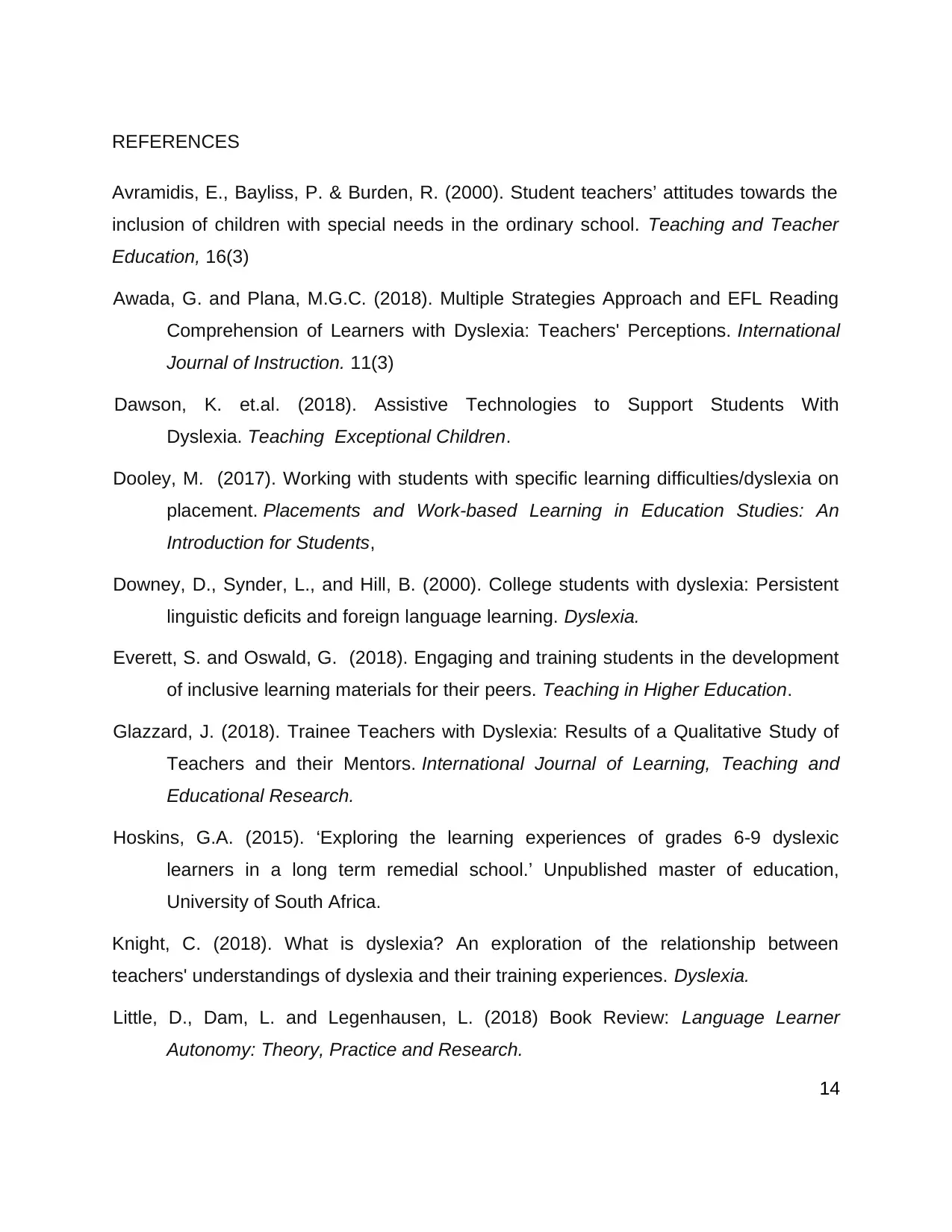
REFERENCES
Avramidis, E., Bayliss, P. & Burden, R. (2000). Student teachers’ attitudes towards the
inclusion of children with special needs in the ordinary school. Teaching and Teacher
Education, 16(3)
Awada, G. and Plana, M.G.C. (2018). Multiple Strategies Approach and EFL Reading
Comprehension of Learners with Dyslexia: Teachers' Perceptions. International
Journal of Instruction. 11(3)
Dawson, K. et.al. (2018). Assistive Technologies to Support Students With
Dyslexia. Teaching Exceptional Children.
Dooley, M. (2017). Working with students with specific learning difficulties/dyslexia on
placement. Placements and Work-based Learning in Education Studies: An
Introduction for Students,
Downey, D., Synder, L., and Hill, B. (2000). College students with dyslexia: Persistent
linguistic deficits and foreign language learning. Dyslexia.
Everett, S. and Oswald, G. (2018). Engaging and training students in the development
of inclusive learning materials for their peers. Teaching in Higher Education.
Glazzard, J. (2018). Trainee Teachers with Dyslexia: Results of a Qualitative Study of
Teachers and their Mentors. International Journal of Learning, Teaching and
Educational Research.
Hoskins, G.A. (2015). ‘Exploring the learning experiences of grades 6-9 dyslexic
learners in a long term remedial school.’ Unpublished master of education,
University of South Africa.
Knight, C. (2018). What is dyslexia? An exploration of the relationship between
teachers' understandings of dyslexia and their training experiences. Dyslexia.
Little, D., Dam, L. and Legenhausen, L. (2018) Book Review: Language Learner
Autonomy: Theory, Practice and Research.
14
Avramidis, E., Bayliss, P. & Burden, R. (2000). Student teachers’ attitudes towards the
inclusion of children with special needs in the ordinary school. Teaching and Teacher
Education, 16(3)
Awada, G. and Plana, M.G.C. (2018). Multiple Strategies Approach and EFL Reading
Comprehension of Learners with Dyslexia: Teachers' Perceptions. International
Journal of Instruction. 11(3)
Dawson, K. et.al. (2018). Assistive Technologies to Support Students With
Dyslexia. Teaching Exceptional Children.
Dooley, M. (2017). Working with students with specific learning difficulties/dyslexia on
placement. Placements and Work-based Learning in Education Studies: An
Introduction for Students,
Downey, D., Synder, L., and Hill, B. (2000). College students with dyslexia: Persistent
linguistic deficits and foreign language learning. Dyslexia.
Everett, S. and Oswald, G. (2018). Engaging and training students in the development
of inclusive learning materials for their peers. Teaching in Higher Education.
Glazzard, J. (2018). Trainee Teachers with Dyslexia: Results of a Qualitative Study of
Teachers and their Mentors. International Journal of Learning, Teaching and
Educational Research.
Hoskins, G.A. (2015). ‘Exploring the learning experiences of grades 6-9 dyslexic
learners in a long term remedial school.’ Unpublished master of education,
University of South Africa.
Knight, C. (2018). What is dyslexia? An exploration of the relationship between
teachers' understandings of dyslexia and their training experiences. Dyslexia.
Little, D., Dam, L. and Legenhausen, L. (2018) Book Review: Language Learner
Autonomy: Theory, Practice and Research.
14
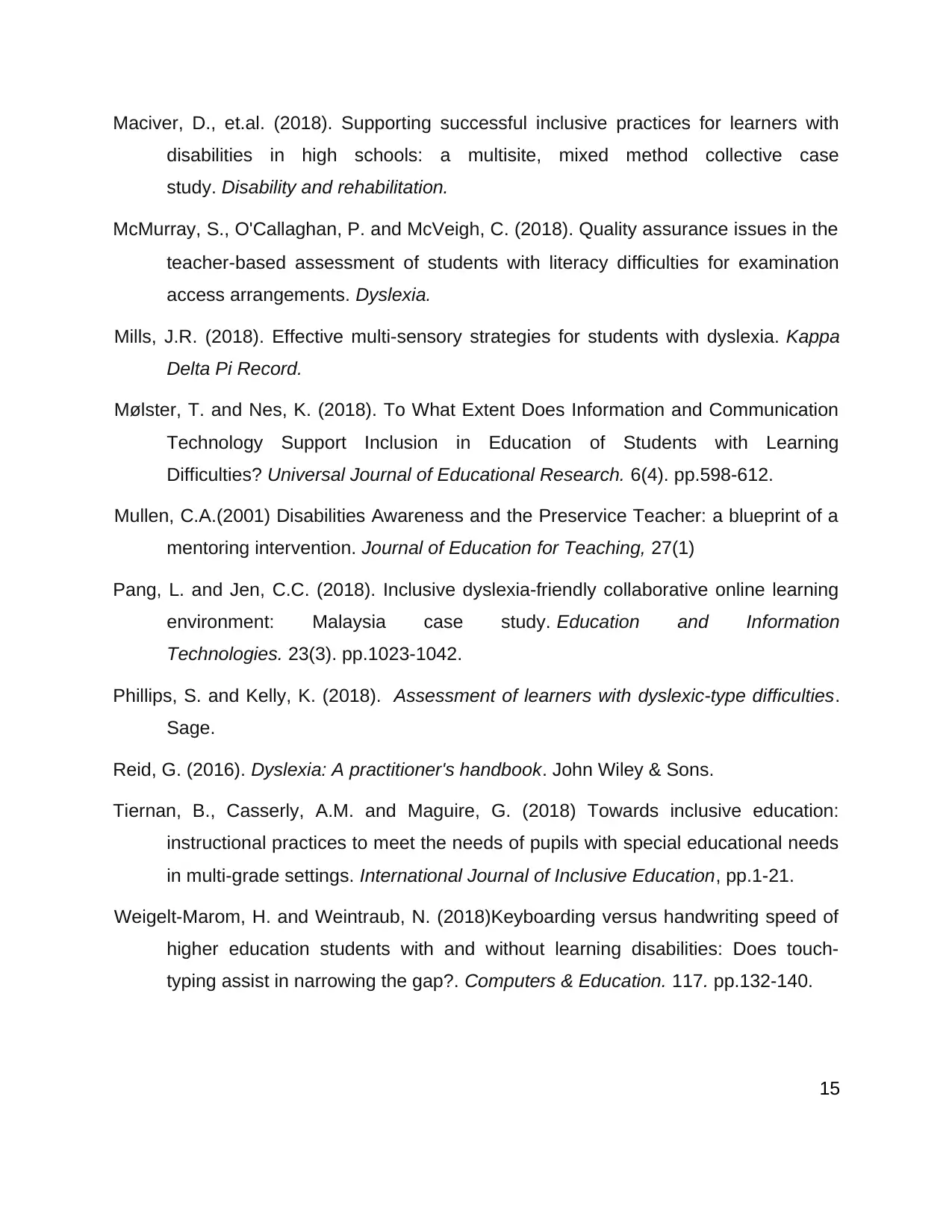
Maciver, D., et.al. (2018). Supporting successful inclusive practices for learners with
disabilities in high schools: a multisite, mixed method collective case
study. Disability and rehabilitation.
McMurray, S., O'Callaghan, P. and McVeigh, C. (2018). Quality assurance issues in the
teacher‐based assessment of students with literacy difficulties for examination
access arrangements. Dyslexia.
Mills, J.R. (2018). Effective multi-sensory strategies for students with dyslexia. Kappa
Delta Pi Record.
Mølster, T. and Nes, K. (2018). To What Extent Does Information and Communication
Technology Support Inclusion in Education of Students with Learning
Difficulties? Universal Journal of Educational Research. 6(4). pp.598-612.
Mullen, C.A.(2001) Disabilities Awareness and the Preservice Teacher: a blueprint of a
mentoring intervention. Journal of Education for Teaching, 27(1)
Pang, L. and Jen, C.C. (2018). Inclusive dyslexia-friendly collaborative online learning
environment: Malaysia case study. Education and Information
Technologies. 23(3). pp.1023-1042.
Phillips, S. and Kelly, K. (2018). Assessment of learners with dyslexic-type difficulties.
Sage.
Reid, G. (2016). Dyslexia: A practitioner's handbook. John Wiley & Sons.
Tiernan, B., Casserly, A.M. and Maguire, G. (2018) Towards inclusive education:
instructional practices to meet the needs of pupils with special educational needs
in multi-grade settings. International Journal of Inclusive Education, pp.1-21.
Weigelt-Marom, H. and Weintraub, N. (2018)Keyboarding versus handwriting speed of
higher education students with and without learning disabilities: Does touch-
typing assist in narrowing the gap?. Computers & Education. 117. pp.132-140.
15
disabilities in high schools: a multisite, mixed method collective case
study. Disability and rehabilitation.
McMurray, S., O'Callaghan, P. and McVeigh, C. (2018). Quality assurance issues in the
teacher‐based assessment of students with literacy difficulties for examination
access arrangements. Dyslexia.
Mills, J.R. (2018). Effective multi-sensory strategies for students with dyslexia. Kappa
Delta Pi Record.
Mølster, T. and Nes, K. (2018). To What Extent Does Information and Communication
Technology Support Inclusion in Education of Students with Learning
Difficulties? Universal Journal of Educational Research. 6(4). pp.598-612.
Mullen, C.A.(2001) Disabilities Awareness and the Preservice Teacher: a blueprint of a
mentoring intervention. Journal of Education for Teaching, 27(1)
Pang, L. and Jen, C.C. (2018). Inclusive dyslexia-friendly collaborative online learning
environment: Malaysia case study. Education and Information
Technologies. 23(3). pp.1023-1042.
Phillips, S. and Kelly, K. (2018). Assessment of learners with dyslexic-type difficulties.
Sage.
Reid, G. (2016). Dyslexia: A practitioner's handbook. John Wiley & Sons.
Tiernan, B., Casserly, A.M. and Maguire, G. (2018) Towards inclusive education:
instructional practices to meet the needs of pupils with special educational needs
in multi-grade settings. International Journal of Inclusive Education, pp.1-21.
Weigelt-Marom, H. and Weintraub, N. (2018)Keyboarding versus handwriting speed of
higher education students with and without learning disabilities: Does touch-
typing assist in narrowing the gap?. Computers & Education. 117. pp.132-140.
15
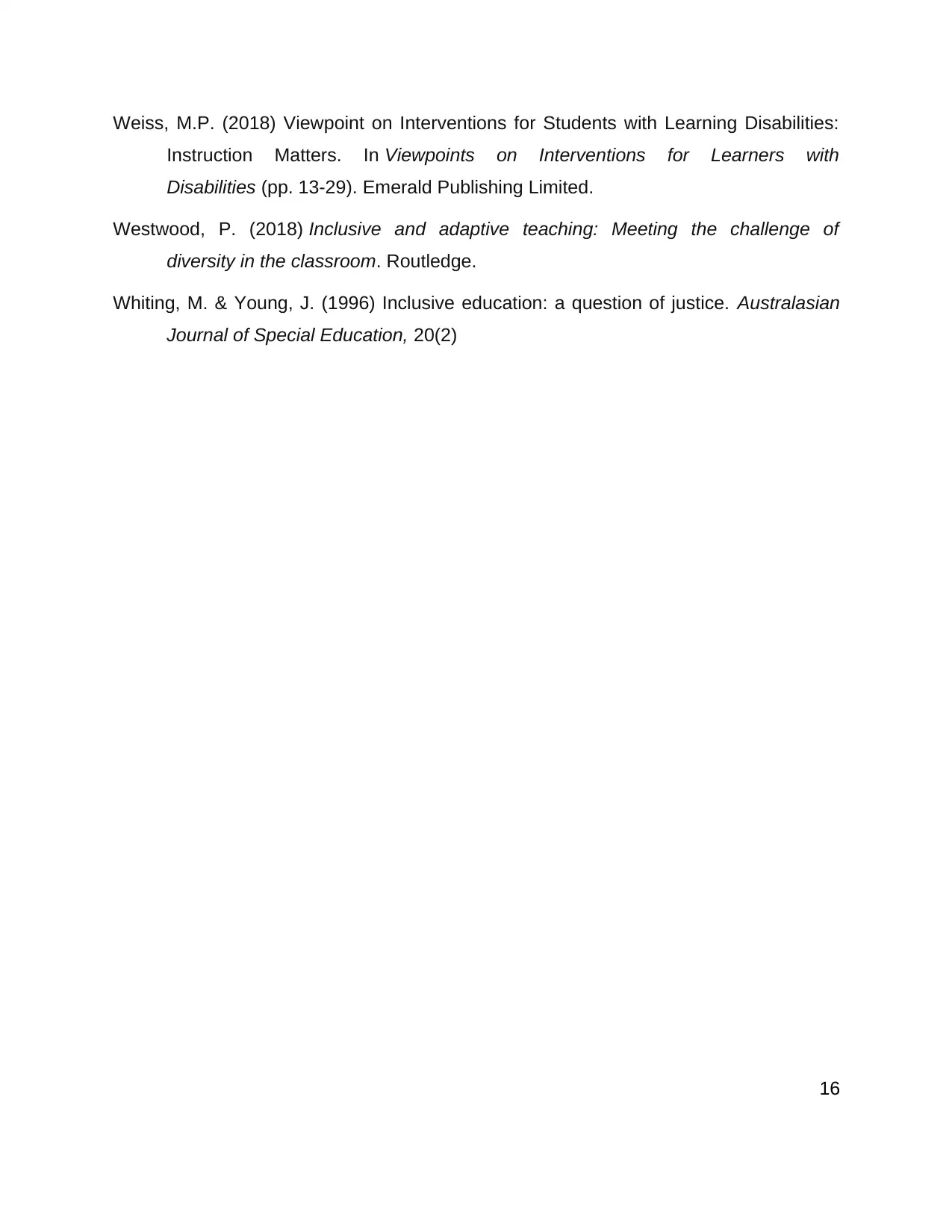
Weiss, M.P. (2018) Viewpoint on Interventions for Students with Learning Disabilities:
Instruction Matters. In Viewpoints on Interventions for Learners with
Disabilities (pp. 13-29). Emerald Publishing Limited.
Westwood, P. (2018) Inclusive and adaptive teaching: Meeting the challenge of
diversity in the classroom. Routledge.
Whiting, M. & Young, J. (1996) Inclusive education: a question of justice. Australasian
Journal of Special Education, 20(2)
16
Instruction Matters. In Viewpoints on Interventions for Learners with
Disabilities (pp. 13-29). Emerald Publishing Limited.
Westwood, P. (2018) Inclusive and adaptive teaching: Meeting the challenge of
diversity in the classroom. Routledge.
Whiting, M. & Young, J. (1996) Inclusive education: a question of justice. Australasian
Journal of Special Education, 20(2)
16
1 out of 16
Related Documents
Your All-in-One AI-Powered Toolkit for Academic Success.
+13062052269
info@desklib.com
Available 24*7 on WhatsApp / Email
![[object Object]](/_next/static/media/star-bottom.7253800d.svg)
Unlock your academic potential
© 2024 | Zucol Services PVT LTD | All rights reserved.





